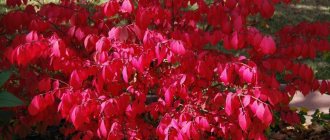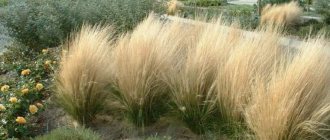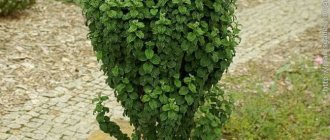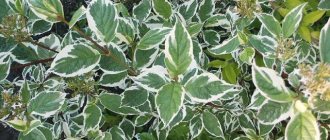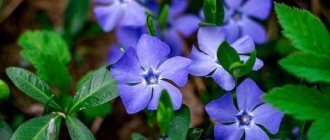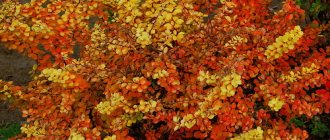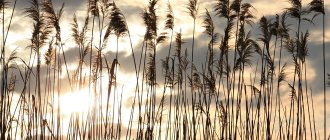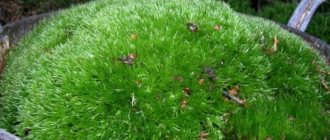Doren is an ornamental shrub, widely used not only for landscaping city parks and squares, but also in gardening. The unique foliage colors of the perennial crop will enliven any landscape design. Due to the unusual color of the trunk, this unpretentious plant does not lose its decorative effect even in winter. Thin reddish branches of turf stick out from the snow-white snowdrifts, reminiscent of summer. And with the arrival of spring, the bush is again covered with beautiful foliage of a multi-colored palette.
Description
Derain (Cornus) comes from Siberia. The dogwood family (Cornaceae) includes more than 30 species. Species diversity is represented not only by deciduous shrubs and low trees, but also by herbaceous ground cover perennials.
The deciduous shrub also has other names - dogwood, svidina, svida.
In the old days, arrows, looms, and later door handles and tennis rackets were made from the durable wood of the plant.
The height of the turf depends on the type: ground cover perennial reaches a maximum height of 30 cm, shrubs grow up to 3 meters. There are also tall varieties of trees - about 7-9 meters.
The color of the leaves is green or variegated. The veins are clearly visible along the edge of the leaf. By autumn, the color of the leaves changes, acquiring new shades - purple, pink or lemon yellow. The trunk of the bush also attracts the eye with unusual colors; it can be red, yellow, pink or bluish (depending on the variety).
In spring, small flowers of various colors appear on the plant, collected in inflorescences - caps. By autumn, the fruits ripen - drupes with two or one seeds, which birds feast on. White, yellow and blue berries are inedible for humans. The elongated red dogwood berries are eaten.
Perennial
In general, more than 90% of shrubs are perennials - every year they become larger, taller, wider. Some species begin to bloom and bear fruit only 4-5 years after planting.
Fieldfare
When choosing both a decorative and fast-growing bush for landscaping your site, do not lose sight of this plant. The bush is not too large (up to 2 m) with leaves similar to fern or ordinary rowan.
Small white flowers are not the only decoration of the fieldfare; its leaves change color as they grow and change years - young shoots are pink, summer shoots are green, autumn shoots are yellow or orange-red.
Derain
The most popular among gardeners is the white derain, which got its name from the white edges on the light-colored leaves. Although the plant sheds its leaves, it still looks beautiful in winter due to its brown, yellow, and scarlet shoots.
Grown in all regions: it tolerates heat, cold, and shade. Grows quickly and is not picky about soil composition.
Kalmiya
Kalmia is rare in the CIS countries, but landscape designers from Europe, the USA and Canada love this shrub and actively use it.
Due to the fact that Kalmia flowers have different shades when closed and open (for example, red and pink), the bush looks very decorative during flowering.
Types and varieties
Derain, which grows spontaneously along roads, along reservoirs and in forests, has been cultivated. Breeders have developed many varietal varieties. Decorative culture looks aesthetically pleasing throughout the year. Let's look at the most common types.
White dogwood (Cornus alba)
The height of the spreading bush reaches three meters. Dogwood is decorative all year round: erect branches are covered with red bark. The leaves are dark green or variegated. It blooms with white flowers almost all summer. White fruits acquire a bluish color by autumn.
Varietal varieties
Elegantissima
The three-meter shrub has a spreading crown. The branches are covered with cherry-colored bark. A white stripe runs along the edges of the bluish-green leaves. By autumn their color changes to orange-burgundy.
Aurea
This compact perennial, 1.5-2 meters in size, delights throughout the entire summer with its unusual combination of red branches with lemon-yellow foliage. By autumn, the leaves change their palette to red and yellow. In May, the svidina blooms with creamy-white flowers; by autumn, blue-white berries ripen on it.
Sibirica
Spreading coral-colored branches reach three meters in height. In winter, they break out from under the snow, like bright fireworks. The dark green variegated leaves turn purple in autumn.
Shpeta (Spaethii)
The ornamental shrub reaches a height of 2.5 meters. Yellow stripes and spots appear on the green leaf plate.
Red Gnome
A low-growing perennial one meter high with bright red shoots and dark green leaves, which become burgundy in color by autumn.
Red dogwood (Cornus Sanguinea) or blood red dogwood
An ornamental shrub measuring about 3 meters stands out clearly against the background of other vegetation. The shoots and leaves are purple. Young ovoid leaves are green in summer and acquire a wine tint by autumn. Against the background of foliage, white buds and blue-black drupes look festive.
Popular varieties
Compressa
A compact one and a half meter shrub with small wrinkled leaves, the color of which changes from dark green to burgundy during the season. Derain does not bloom, fruits are not formed on it.
Midwinter Fire
A variety of turf that is especially decorative in winter. The orange-red shoots, like fiery arrows, rise above the snow-white snowdrifts.
Green Light
A spreading variety of red turf about two meters high. The shoots are orange-green, the leaves change color in autumn from bright green to dark red. It blooms in June with white fragrant flowers.
Sprouting dogwood (Cornus stolonifera)
Resembles white turf. It is distinguished by a large number of basal shoots. In contact with the soil, flexible shoots quickly take root. This variety is planted on slopes to strengthen the soil, and also as a hedge, which grows quickly, forming a dense crown.
Varietal varieties
Kelsey
A dwarf variety with a maximum height of 0.7 meters. Green leaves turn yellow or fiery red in autumn.
Flaviramea
The two-meter shoots of the svidina are olive-colored. The leaves are glossy, their color is green, changing to red with the arrival of autumn. Blooms all summer with white flowers.
White gold
The variegated leaves make the plant especially decorative: the white border is clearly visible against the green background.
Canadian dogwood (Cornus canadensis)
Creeping, slow-growing subshrub with herbaceous shoots covered with sparse hairs. The green leaves are collected in brushes: 4-6 leaves in each. Blooms in June with small white flowers. Red drupes ripen in August. Creeping turf is widely used in landscape design.
Flowering dogwood (Cornus Florida)
A tree with an average height of 120 cm. During flowering, it fascinates with its beauty: white or pink flowers cover the entire crown of the plant.
Highlights
A living fence is a series of planted plants that, when they grow, create an impenetrable barrier. The most important requirement for crops is high foliage density so that the inner courtyard area is not visible from the street. Most plants grow so well that it becomes more difficult to overcome this obstacle if there is a high concrete fence. The advantages of this alternative:
- The area is saturated with oxygen - the leaves will be ventilated, and nothing will interfere with air circulation.
- Well-growing plants will provide cool shade - it will be pleasant to be near them in the summer heat.
There are of course some disadvantages:
- The fence cannot be installed right away - it takes a couple of years to grow, and for this reason, initially the fences are supplemented with ventilated metal gratings, which after a while will be hidden in the foliage and will serve as an additional barrier to strangers.
- This is not the cheapest pleasure, and the cost consists of plants, a metal fence along which it is planted, wasted water, fertilizers and time for care.
- Such a fence requires regular monitoring and maintenance. Although the plant is unpretentious, this does not mean that it can be planted and forgotten about for a long time. At a minimum, you need to mow regularly and water everything periodically, and all this will take not only money, but also time.
- Insects may appear on plants and bother people. Diseases may still form. This requires additional attention, and the hedge needs to be sprayed with substances that make it not so clean in environmental terms, at least until the first rainstorm.
In general, hedges are planted mainly in park areas. But even in cottages you can find them, and in our country this is not so common, but the fashion for naturalness is taking its toll. Derain is a crop that gardeners in the Russian Federation are especially fond of, and such a plant has incredible beauty that blooms all year round. In summer, its lush crown is covered with cream-colored flowers, and in autumn the foliage turns deep red. The main colors are pink and burgundy. In winter, the bushes are decorated with bright fruits that seem to burn against the backdrop of snow-white snow. In spring, juicy and young greenery will appear again, filling the space with freshness.
How to care
Derain is hardy and unpretentious. Caring for the crop is not difficult.
Soil selection
When growing turf, soil nutrition plays a significant role. On a fertile, moist and drained substrate, the perennial will smell fragrant. The acidity of the soil should be neutral.
Location and lighting
The plant feels great both in sunny areas and in partial shade. For varietal varieties of turf with colored shoots, it is recommended to choose sunny places; direct rays of the sun will enhance the color of the shoots. It is important to take into account when choosing a place that it is not strongly blown by the cold wind.
Temperature, humidity, watering
Substrate moisture is the key to good growth and decorativeness of the crop. Young seedlings are especially sensitive to drought. In the first month after planting, the plants are watered every other day, and then switched to once weekly watering. The soil should remain moderately moist.
Mature turf tolerates short-term drought well. But if there is no watering for a long time, the leaves can wither, even dry out completely. If the bush is watered abundantly (3-4 buckets), the elasticity of the leaf plates is restored.
It is advisable to monitor watering in hot weather and not to stress the perennial. Irrigation is recommended in the evening.
Mulching will help retain moisture, protect the root system from overheating, and in winter, from hypothermia. As mulch, you can use compost, which is used to cover the tree trunk circle without touching the trunk and the base of the shoots.
Fertilizers and fertilizers
Seasonal feeding is necessary for healthy growth and development of the plant. In the spring, during the growing season, you need to feed with fertilizer containing nitrogen. In summer, you can add peat or compost. In the fall, potash fertilizing is recommended to help the turf more easily withstand low temperatures.
Transfer
Derain can be replanted both in autumn and spring. The stages of transplantation are as follows:
- prepare a fertile substrate: mix humus or compost (2 parts), peat and sand (1 part each), leaf soil (2 parts);
- dig a planting hole, the size of which should be twice the size of the root system;
- pour large expanded clay or broken bricks onto the bottom of the pit;
- fill the drainage with earthen mixture;
- Place the seedling in the hole and fill it with the remaining fertile soil. Leave the root collar above the ground;
- Compact the soil around the plant and water generously.
If you want to create a hedge from turf, you need to dig a trench of the required length. Plant a perennial in it, maintaining a distance between seedlings of 35-75 cm (depending on the varietal variety).
Trimming
Pruning is an important step in turf care. To prevent the bush from losing its decorative appearance, it is trimmed regularly.
Young branches have a bright, rich color; with age, their color changes to brown, losing its brightness. Experienced gardeners remove old shoots every year in March so that the bush remains elegant in winter.
Another way to preserve the decorative appearance of a perennial is as follows: after two or three years, the old branches are shortened, leaving their length no more than 30 cm from the soil. This procedure is necessary to stimulate the active growth of new shoots. In this case, you need to know the following fact: with this method of pruning, the bush will not bloom; flowers appear on two-year-old shoots.
Ground cover varieties of turf and varieties that grow as trees do not need to be trimmed. Shortening shoots applies only to shrub species.
The first procedure can be performed in the third year after planting, when the plant is well rooted and strengthened.
Aged turf can be rejuvenated. To do this, in early spring it is necessary to cut off all shoots at a distance of 15 cm from the ground. The young shoots will not keep you waiting long.
Winter care
Deren is not afraid of winter frosts. Does not require winter shelter. You can cover the plant with snow to be on the safe side. The exception is certain types of crops - heat-loving varieties, for example, Japanese dogwood and a number of others.
Planting turf
The most convenient place for planting dogwood is a semi-shaded area with maximum sunlight for 3-5 hours . This will be enough for the comfortable growth of the bush.
- Planting should be done in the spring, when the weather is relatively warm.
- The hole should be commensurate with the roots of the dogwood.
- The root collar is deepened by 3 cm.
- The landing site is watered generously with ten liters of water with the addition of “Kornevin”.
- All shoots must be trimmed by 1/3.
- When planting for the first time, it is necessary to add loose, fertile soil to the holes so that the dogwood can grow its root system well over the years.
Reproduction methods
Derain can be propagated in several ways.
Cuttings
After flowering, select a stem: it should break when bent. Cut the cuttings at an angle, leaving 2-3 internodes on it. Plant in an earthen substrate prepared in equal parts from sand and universal soil. Water and cover the planting container with a plastic bag. Move the pot to a shady corner of the garden, monitor the soil moisture, it should not dry out.
After 5-6 weeks the cutting will take root. The appearance of a new sprout will indicate that the seedling has grown. The bag must be removed and the pot moved to a brighter place. Watering should be regular.
A grown young plant with new leaves must be transplanted into a larger pot with fertile soil. Transfer to a cool room for the winter. In spring, plant in a permanent place in the garden.
You can prepare tree cuttings in the fall. Place the planting material in a bag of river sand and store it in the refrigerator. At the end of spring, plant in open ground.
Layerings and root suckers
The most convenient and fastest method of turf propagation. Early in spring or at the end of August, prepare a small trench and place a thin side branch in it. Secure with wire, cover with fertile soil with compost added to it. Leave the top of the stem above the ground.
Monitor soil moisture. After 2-3 months, roots will appear. The strengthened plant is separated from the mother plant and planted in a permanent place.
Dividing the bush
The overgrown turf is dug up and the roots are cleared of excess soil. Cut the bush into several parts with a sharp knife. They are planted in a new place in prepared holes, covered with fertile soil, and watered.
Seeds
This method is suitable for the most patient gardeners; it will take a lot of time to germinate the seeds. Seeds collected independently from hybrid varieties are sterile. Planting material can be purchased in specialized stores.
Seeds must undergo a stratification procedure: for this they are placed in a refrigerator with a temperature no higher than three degrees. Then the seed material is sown in a planting container with a mixture of peat and sand. The temperature for germination should not fall below 18 degrees, the soil must be irrigated regularly.
When the 4th leaf appears, the plants dive, planting one at a time in pots with fertile substrate. Planting outdoors is carried out after 2 years of growing in a pot at home.
Simple cuttings
The flowering period has ended. The beginning of July is the optimal time to take cuttings for planting. Select annual shoots at the stage of wood hardening. The rods are cut to medium length and treated with stimulating solutions or biostimulants. Planted in a greenhouse at an angle. In 2-3 months, roots will form. Layering is quick and convenient. When cleaning the bushes, do not forget to leave a couple of lower branches. Bend them to the ground, carefully place them in the groove made, so that half of the branch is tightly pressed and covered (you can use a wire pin). It is necessary to control the rooting process based on the condition of the above-ground tip. If it develops well, it will signal the success of the “business.” All that remains is to dig it up, separate it and plant it in a permanent place. It is more practical to propagate garden pigs from an excellent “pedigree” by grafting buds onto wild-growing species.
Possible problems
The shrub has lost its decorative value, which means that errors were made when caring for the plant. When errors are eliminated, the derain will again delight with its beauty.
The bush is untidy, with “bald” or shoots sticking out to the side: the plant needs a haircut.
Leaves are limp, drooping: this usually happens during prolonged drought. Abundant watering will return the plant to a healthy appearance.
Spots and plaque have appeared on the leaves, leaf plates are curling: these are signs of a disease that needs to be identified and measures taken to combat it.
Diseases and pests
An adult plant has good immunity and gets sick extremely rarely. With high humidity and thickening, perennials can develop fungal diseases - powdery mildew or gray mold. When the first signs of disease are detected, the turf should be treated with Bordeaux mixture. Chemical preparations “Vector” and “Hom” will also help cope with these diseases. In the fight against uninvited guests - aphids and scale insects - tobacco decoction, infusion of yarrow or potato tops will help. If there is a large infestation, chemicals such as Karbofos will be required.
How to grow a hedge from turf
A turf hedge is an excellent alternative to building a fence. Plants will saturate the area with oxygen. The foliage will not interfere with the air circulation. On a sunny day, the pig will cast a shadow, creating coolness. As it grows, it forms an impenetrable wall for outsiders.
Growing a living fence from turf is not difficult; turf grows quickly. Plants are planted tightly in a row. When planting, you need to take into account varietal characteristics in order to correctly choose the optimal distance between plants.
White dogwood elegantissima
Elegantissima looks attractive throughout the year. Goes well with birch and coniferous trees. Does not require special care, except for haircuts. When planting red rose elegantissima, it is better to fertilize the soil with compost and humus. Turf grows quickly and efficiently. perfectly in shady areas , even where the sun almost never sets.
The leaves are dark green inside, white on the edges with a light green edge. The shoots are smooth, the branches are high, dense and elastic. Elegantissima is a honey plant with a subtle, barely noticeable aroma.
Deren: photo
Using shrubs in landscape design
Hardy, fast-growing turf is indispensable in both urban and garden landscapes:
- it gets along well with coniferous and flower crops, any composition with it will be inimitable;
- responds favorably to a haircut: geometric shapes and images of animals in parks captivate the eye;
- turf planted along benches and gazebos protects from wind and scorching sun;
- In autumn, the derain brings bright colors to a dull landscape, in winter it enlivens a snow-covered park or garden;
- perennial shrubs are planted to strengthen ravines and coastal zones;
- create hedges.
Do you want to make your garden or plot of land bright and original? Then don't forget about the turf. The perennial crop will fill your favorite corner with rich colors not only in the warm season, but also in the dull autumn-winter season. In addition, this non-capricious perennial will not require costly and time-consuming care, and will give a lot of joyful emotions.
Deren shpet
Derain is a shrub that is popular among gardeners and grows in almost every yard. If you don’t already have this plant on your property, then you simply don’t know about its benefits. It also has such a name as pork. This bush attracts the attention not only of amateur gardeners, but also of landscape designers and advanced professional gardeners. Its attractiveness is that it has a beautiful shape and is easy to care for, as well as the diversity of its varieties. Everyone will find their own variety in this form. It takes pride of place among the plants that can be planted in the garden. Deren shpet is considered the main decoration in the garden, a background if you like. Derain has about fifty species in its genus. And there are more than twenty varieties. Distributed mainly in the Northern Hemisphere of the Earth. It is evergreen and rarely occurs in tree form. This type of derain was bred approximately more than a thousand years ago in the city of Shpet.
